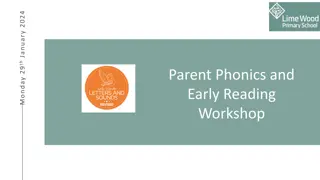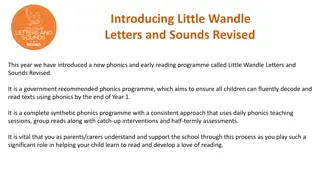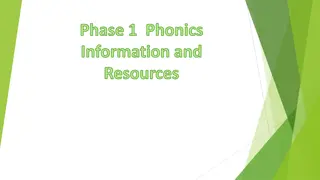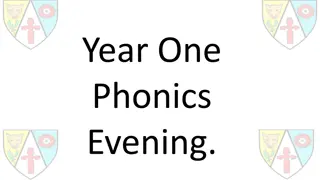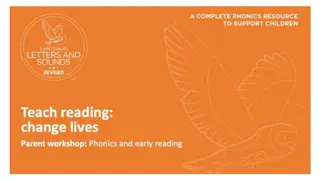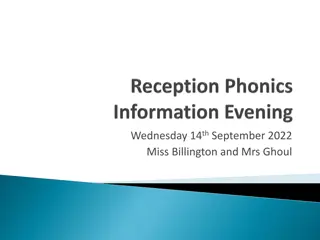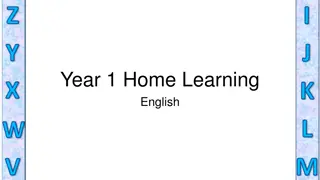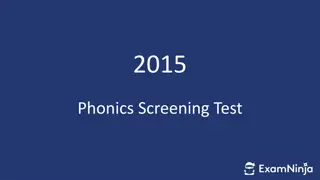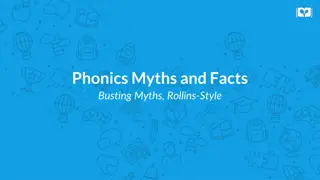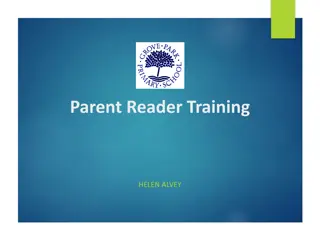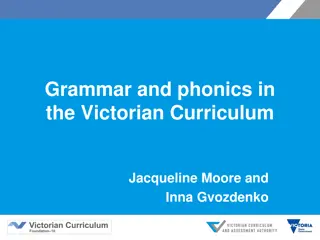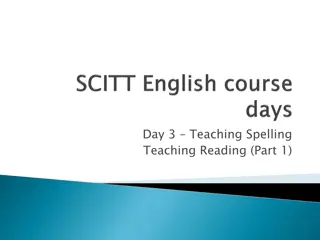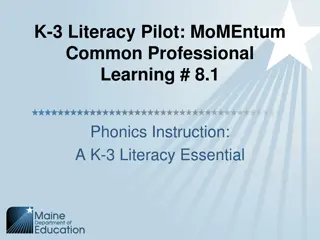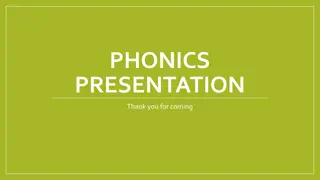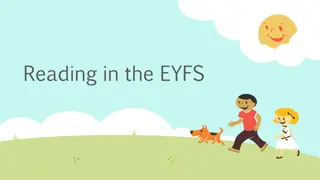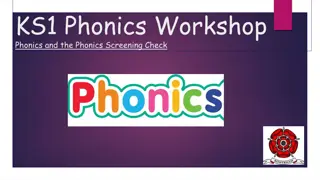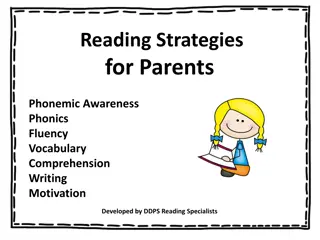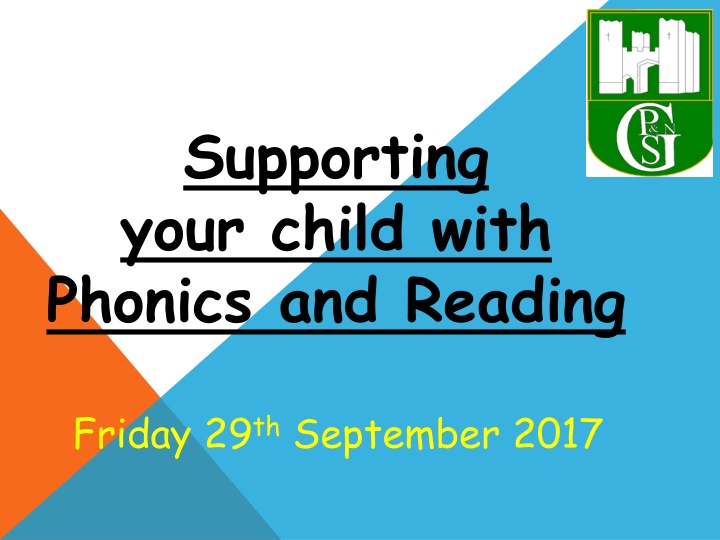
Supporting Your Child with Phonics and Reading Tips
Learn how phonics is taught at Garlinge, understand basic phonics terms, and boost your confidence in helping your child with reading. Discover the importance of phonics, the Letters and Sounds programme, and key phonics terms your child will encounter. Dive into the five phases of Letters and Sounds and find valuable resources to assist your child's reading journey.
Download Presentation

Please find below an Image/Link to download the presentation.
The content on the website is provided AS IS for your information and personal use only. It may not be sold, licensed, or shared on other websites without obtaining consent from the author. If you encounter any issues during the download, it is possible that the publisher has removed the file from their server.
You are allowed to download the files provided on this website for personal or commercial use, subject to the condition that they are used lawfully. All files are the property of their respective owners.
The content on the website is provided AS IS for your information and personal use only. It may not be sold, licensed, or shared on other websites without obtaining consent from the author.
E N D
Presentation Transcript
Supporting your child with Phonics and Reading Friday 29th September 2017
AIMS To share how phonics is taught at Garlinge. To teach the basics of phonics and some useful terms. To develop parents confidence in helping their child with phonics and reading.
We follow the Letters and Sounds programme. This is a synthetic phonics framework that was set out by the Department for Education. What is phonics? What is phonics? It sets out a suggested programme of teaching children the sounds and the letters of the alphabet in order to segment and blend. These are the necessary skills required to decode words to read and write. Letters and Sounds starts in Phase one which begins in Foundation Stage and progresses through Key Stage 1 until all Phases are complete.
PHONICS TERMS YOUR CHILD WILL LEARN Diagraph: Two letters that make one sound when read. Trigraphs: Three letters that make one sound. CVC: Stands for consonant, vowel, consonant. Segmenting is breaking up a word into its sounds. Blending : Putting the sounds together to read a word Tricky words/Alien word/Pseudo word: Words that cannot easily be decoded.
Letters and Sounds is taught through 5 phases from Nursery to Year 2 Phase 1: Explores environmental sounds and how sounds are produced. Phase 2: Introduces the first 19 phonemes Phase 3: Explores the next 26 phonemes Phase 4: Consolidation unit where we explore blending, and segmenting . Phase 5: Explores alternative pronunciations of graphemes For more information please refer to Letters and Sounds Guidance DFE.
How is Phonics taught in School? Every day the children have a 30 minute session of phonics. Fast paced approach. Lessons encompass a range of games, songs and rhymes. We build upon this knowledge throughout the school day. Additional interventions
Your child will learn to use the terms: Children need to be able to Children need to be able to hear sounds in a word and then blend them sounds in a word and then blend them together to together to say say the whole word . the whole word . hear the separate the separate
Phonic Session Year 1
Tricky word, Alien Word, Pseudo Word? Children are taught high- frequency words, including tricky words... is to he she it the no go I in at and as an example.
The phonics screening check is designed to confirm whether pupils have learnt phonic decoding to an appropriate standard. The check consists of 20 real words and 20 pseudo-words that a pupil reads aloud to the teacher.
Phonics Screening Check Week 2018 Monday 11th June 2018
Image result for clipart of parent and child on computer How can I help at home?
Most children learn best when they are doing something for a real purpose and because they want to, so playing games is an easy way to support their learning. Here are some great suggestions for activities and games you can do at home or out and about. https://www.oxfordowl.co.uk/welcome- back/for-home/reading-owl/fun-ideas
http://tse1.mm.bing.net/th?id=OIP.M238be681fc18968d4c37d8f4ff9c8eb6o0w=300h=150c=0pid=1.9rs=0p=0r=0http://tse1.mm.bing.net/th?id=OIP.M238be681fc18968d4c37d8f4ff9c8eb6o0w=300h=150c=0pid=1.9rs=0p=0r=0 Practise the phonemes together. Use them to make different words at home and play phonics games. Read everyday with your child if possible.
Image result for clipart of parent and child on computer USEFUL WEBSITES http://www.oxfordowl.co.uk/question/index/3 Lots of information and guidance for Parents and Carers. http://www.phonicsplay.co.uk/ParentsMenu.htm A selection of interactive games for all phonic phases. https://www.phonicsplay.co.uk/freeIndex.htm The free area of the Phonics Play website is filled with free interactive games, phonics planning, assessment ideas and printable resources. www.ictgames.com/literacy.html A great selection of games that link well with Letters and Sounds. http://www.letters-and-sounds.com/ Printable resources for each of the Letters and Sounds phonic phases, also links to games aligned with each phase.
USEFUL WEBSITES http://www.letters http://www.letters- -and Printable resources for each of the Letters and Sounds phonic phases, also links to games aligned with each Printable resources for each of the Letters and Sounds phonic phases, also links to games aligned with each phase. phase. and- -sounds.com/ sounds.com/ https://www.kizphonics.com/products/ https://www.kizphonics.com/products/ Differentiated interactive phonics materials. Differentiated interactive phonics materials. http://www.ngfl http://www.ngfl- -cymru.org.uk/vtc/ngfl/ngfl cymru.org.uk/vtc/ngfl/ngfl- -flash/alphabet Letter names come up in alphabetical order. Letter names come up in alphabetical order. flash/alphabet- -eng/alphabet.htm eng/alphabet.htm http://www.bbc.co.uk/schools/wordsandpictures/index.shtml http://www.bbc.co.uk/schools/wordsandpictures/index.shtml Activities for all phases. Activities for all phases. http://www.bbc.co.uk/schools/ks1bitesize/literacy/phonics/index.shtml http://www.bbc.co.uk/schools/ks1bitesize/literacy/phonics/index.shtml Phonics games with a choice of difficulty (some HFWs, some vowel blends, very varied) Phonics games with a choice of difficulty (some HFWs, some vowel blends, very varied) http://www.bigbrownbear.co.uk/magneticletters/ http://www.bigbrownbear.co.uk/magneticletters/ Make any real or pseudo words with this resource. Make any real or pseudo words with this resource. http http://www.garlingeprimary.co.uk/pupils ://www.garlingeprimary.co.uk/pupils- -area Garlinge Primary School website which has links to phonics and reading games. Garlinge Primary School website which has links to phonics and reading games. area- -english.php english.php
THE 4 TYPES OF READERS THE 4 TYPES OF READERS Decoding and language comprehension Decoding and language comprehension + good decoding poor decoding good language comprehension good language comprehension good decoding poor decoding poor language comprehension poor language comprehension -
Strategies to help us understand and enjoy reading. As we read we .. How why ? Predict Text to self I wonder Text to world knowledge Text to text Predict, ask questions Predict, ask questions, , I wonder I wonder and read on to find and read on to find out... Visualise Visualise Use our background Use our background k knowledge and nowledge and connect to text connect to text out... I ve broken down but I have a plan to fix it I think I ve broken down Watch out for VIP words/ phrases/ideas Notice breakdown and and put together to build GIST and and repair it
Reading Lessons at Reading Lessons at Garlinge Garlinge Reading lessons are daily. Teachers teach whole class through a shared text. Teachers to also monitor phonics progression through focussed reading groups.



